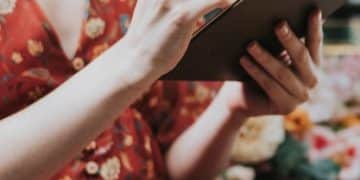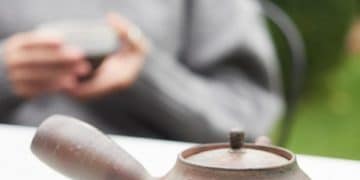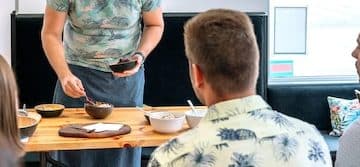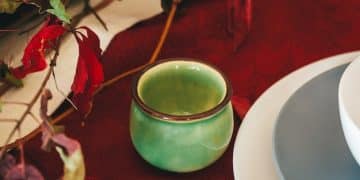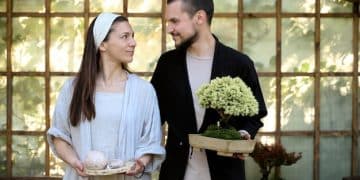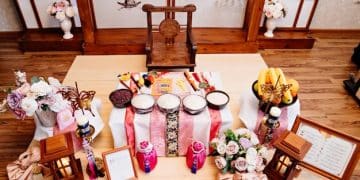Korean Tea Ceremony Etiquette: A Beginner’s Guide for US Participants
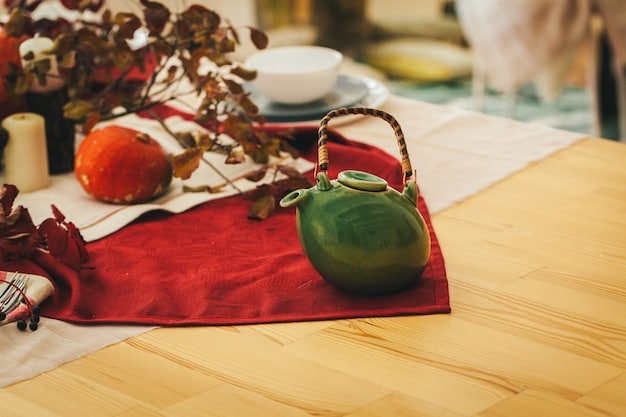
Korean Tea Ceremony Etiquette: A Beginner’s Guide for US Participants prepares US participants for the traditional Korean tea ceremony, covering essential aspects like appropriate attire, bowing protocols, tea preparation, and respectful interaction, ensuring a culturally enriching experience.
Embarking on a Korean tea ceremony is a journey into a world of grace, respect, and history. For US participants, understanding the nuances of Korean Tea Ceremony Etiquette: A Beginner’s Guide for US Participants can significantly enhance the experience, turning it into a cherished memory.
Understanding the Korean Tea Ceremony
The Korean tea ceremony, known as “darye” (茶禮), is more than just drinking tea; it’s a profound cultural practice that reflects Korean history, philosophy, and values. It’s a moment to slow down, appreciate beauty, and foster harmony between the host and guests.
Before diving into the specifics of etiquette, it’s helpful to grasp the ceremony’s purpose and significance. Darye emphasizes mindfulness, respect, and creating a tranquil environment. Here’s a glimpse of what you need to know.
The Significance of Darye
Darye is deeply rooted in Confucian traditions, emphasizing respect for elders and ancestors. It’s also influenced by Buddhist principles, promoting mindfulness and inner peace.
Variations of the Tea Ceremony
There are several types of Korean tea ceremonies, including those performed for ancestral rites, special occasions, and casual gatherings. However, the underlying principles of respect and mindfulness remain consistent across all variations.
- Royal Tea Ceremony: Held for royal family members, it involves elaborate procedures and exquisite tea sets.
- Ritual Tea Ceremony: Dedicated to ancestors, it shows respect and remembrance.
- Everyday Tea Ceremony: A more relaxed version practiced at home with friends and family.
Regardless of the type, being aware of the etiquette involved will help you navigate the occasion, no matter what it is.
Understanding the Korean tea ceremony sets the stage for appreciating the importance of proper etiquette fully. It’s about more than just following rules; it’s about honoring a tradition and showing respect for Korean culture.
![A close-up shot of hands meticulously arranging traditional Korean teaware in preparation for a tea ceremony. The teaware includes a small teapot, several teacups, a cha seon (tea scoop), and other implements, all set on a beautifully textured wooden tray. The background is blurred to focus attention on the hands and teaware, highlighting the care and precision involved in the ritual.]](https://newsdoramauniverse.com/wp-content/uploads/2025/08/newsdoramauniverse.com_14_1754550069_3e80bef5_internal_1.jpg)
Essential Preparations for US Participants
Preparing for a Korean tea ceremony as a US participant involves understanding the basic elements of the ceremony and how to dress and act appropriately. These preparations will ensure you show respect and make the most of the experience.
From attire to understanding basic Korean phrases, these preparations will help you embrace the tradition with confidence and grace.
Appropriate Attire
While it is unlikely that you’ll be expected to wear a hanbok (traditional Korean clothing), dressing respectfully is essential. Opt for modest, conservative clothing. Avoid overly casual or revealing outfits.
Gifts for the Host
Bringing a small gift for the host is a thoughtful gesture. Consider items like high-quality tea, traditional Korean snacks, or a small item that represents your culture.
Basic Korean Phrases
Learning a few basic Korean phrases will demonstrate your respect and willingness to engage with the culture. Simple phrases such as “Annyeonghaseyo” (hello), “Gamsahamnida” (thank you), and “Jal meogeotseumnida” (I enjoyed the meal) can go a long way.
Preparing for the ceremony involves selecting modest attire and considering a thoughtful gift for the host. Basic Korean phrases will enhance your interaction and demonstrate respect.
Entering the Tea Ceremony Space
The way you enter and behave in the tea ceremony space is crucial as it sets the tone for the entire experience. Koreans place a high value on respect, and your actions upon entering the space should reflect this.
Being mindful of how you conduct yourself from the moment you enter the space demonstrates not only politeness but also profound respect for the tradition you are about to participate in.
Mindful Entrance
Enter the tea ceremony space calmly and quietly. Avoid loud talking or disruptive behavior. Remove your shoes before entering, as is customary in many Korean homes and traditional spaces.
Seating Arrangements
Pay attention to the seating arrangements. Typically, the host will indicate where guests should sit. Elders or honored guests usually sit in the most prominent positions.
When you are sitting, try to maintain good posture. Avoid slouching or fidgeting, as this can be seen as disrespectful.
- Entering the Space: Enter calmly and quietly, and remove your shoes at the entrance.
- Seating Etiquette: Wait for the host to guide you to your seat, and maintain good posture.
- Respectful Demeanor: Avoid loud talking or disruptive behavior; maintain a respectful attitude.
Entering the tea ceremony space requires mindfulness and respect. Remove your shoes, await seating guidance, and maintain a calm and respectful demeanor to honor the tradition and the host.
![Three participants, two women and one man, seated in a traditional Korean tea room, participating in a tea ceremony. The women are wearing elegantly simple, modern hanboks in muted, earthy tones, while the man is wearing a respectful business casual outfit. They are all seated on cushions around a low tea table set with traditional celadon teaware. The room has traditional Korean paper windows, allowing soft, diffused light to fill the space, highlighting the tranquility and simplicity of the ceremony.]](https://newsdoramauniverse.com/wp-content/uploads/2025/08/newsdoramauniverse.com_14_1754550069_3e80bef5_internal_2.jpg)
The Bowing Protocol (Jeol)
Bowing, or “jeol,” is a fundamental aspect of Korean etiquette, especially in formal settings like the tea ceremony. It is a sign of respect, gratitude, and humility. Understanding the different types of bows and when to use them is essential for US participants.
Mastering the art of bowing will demonstrate your understanding and respect for Korean customs, enhancing your credibility and showing deep appreciation for the ceremony.
Types of Bows
There are two main types of bows: the formal bow (keunjeol) and the informal bow (banjeol). The formal bow is reserved for special occasions and shows deep respect, whereas the informal bow is used in everyday situations.
How to Perform a Bow
To perform an informal bow, stand straight with your feet together and your hands at your sides. Bend from the waist, keeping your eyes lowered, and bow at about a 45-degree angle. For a formal bow, kneel and place your hands on the floor before bending forward.
When to Bow
In a tea ceremony, you typically bow to the host upon arrival and before and after receiving tea. Bowing shows respect for the host’s efforts and gratitude for their hospitality.
- Formal Bow (Keunjeol): Used on special occasions to show deep respect.
- Informal Bow (Banjeol): Used in everyday situations to show politeness.
- Bowing Protocol: Bow to the host upon arrival and before and after receiving tea to show gratitude and respect.
Mastering the bowing protocol is vital for showing respect in a Korean tea ceremony. Understand the types of bows and when to use them to demonstrate your understanding and appreciation for Korean customs.
Receiving and Drinking Tea
Receiving and drinking tea during the Korean tea ceremony is a ritual in itself. The way you handle the teacup and sip the tea reflects your respect for the host and the tradition. There are specific steps and customs you should follow to ensure you’re participating correctly.
Being mindful of these actions not only enhances the sensory experience of the tea but also elevates it to a moment of shared respect and harmony between you and the host.
Holding the Teacup
Hold the teacup with both hands as you receive it. This shows respect and attentiveness. Avoid holding the cup with only one hand or gripping it too tightly.
Sipping the Tea
Take small, deliberate sips of the tea. Avoid gulping or making loud noises. Allow the tea to linger on your palate, savoring the flavor and aroma.
Expressing Appreciation
After taking your first sip, it’s customary to express your appreciation to the host. A simple “Thank you” or “The tea is very good” in Korean demonstrates your gratitude.
- Holding the Cup: Use both hands to hold the teacup, showing respect for the host and the ceremony.
- Sipping Etiquette: Sip the tea slowly and deliberately, savoring the flavor and aroma.
- Expressing Gratitude: Thank the host after your first sip to show appreciation.
Receiving and drinking tea involves holding the cup with both hands, savoring each sip, and expressing appreciation to the host. These actions enhance the ceremony’s significance and demonstrate your respect for Korean traditions.
Conversation and Interaction
Engaging in conversation during the Korean tea ceremony strikes a balance between mindfulness and interaction. The topics you discuss and the way you communicate can contribute to the overall harmony of the event.
Your engagement is an opportunity to build connections, deepen your understanding of Korean culture, and foster a sense of shared experience with those around you.
Choosing Appropriate Topics
Stick to light, positive topics such as the tea, the weather, or general aspects of Korean culture. Avoid controversial or sensitive subjects that could disrupt the peaceful atmosphere.
Listening Attentively
Pay close attention to what others are saying. Show that you are engaged by nodding, making eye contact, and responding thoughtfully. Active listening is highly valued in Korean culture.
Speaking Softly
Keep your voice low and speak softly. The tea ceremony is meant to be a tranquil experience, and loud talking can be disruptive. Maintain a calm and gentle tone throughout the interaction.
- Topic Selection: Keep the conversation light and positive, focusing on the tea or aspects of Korean culture.
- Active Listening: Listen attentively and show engagement through eye contact and thoughtful responses.
- Soft Voice: Speak softly to maintain the tranquil atmosphere of the tea ceremony.
Conversation and interaction during the tea ceremony should focus on light, positive topics, active listening, and maintaining a soft voice. These practices ensure a harmonious and respectful experience.
| Key Aspect | Brief Description |
|---|---|
| 🍵 Tea Preparation | Learn how to prepare tea properly, including water temperature and steeping time. |
| 🙇 Bowing Etiquette | Understand the bowing protocol for showing respect during the ceremony. |
| 🙏 Mindful Interaction | Engage mindfully in the ceremony, respecting the silence and meditative aspects. |
| 🍵 Tea Serving | Serve tea to others before serving oneself as a sign of respect. |
Frequently Asked Questions
▼
Opt for modest and respectful attire. While wearing a hanbok is unnecessary, avoid overly casual or revealing clothing. Dressing conservatively shows respect for the tradition.
▼
Show respect by bowing to the host, receiving the teacup with both hands, sipping the tea slowly, and expressing gratitude. Active listening and maintaining a calm demeanor are also crucial.
▼
Avoid controversial or sensitive topics that could disrupt the peaceful atmosphere. Stick to light, positive topics such as the tea itself, the weather, or general aspects of Korean culture.
▼
Yes, it’s acceptable to ask questions, but do so respectfully and at appropriate moments. Inquire about the tea, the teaware, or aspects of the ceremony that you find interesting.
▼
Prepare by dressing appropriately, learning basic Korean phrases, bringing a small gift for the host, and understanding the etiquette involved. Familiarize yourself with the bowing protocol and tea-drinking customs.
Conclusion
Participating in a Korean tea ceremony is an enriching experience that offers a glimpse into the heart of Korean culture. By understanding and practicing the etiquette outlined in this guide, US participants can ensure they show proper respect, foster meaningful connections, and fully appreciate the beauty and serenity of this time-honored tradition. Embracing these customs will not only enhance your experience but also create lasting memories of cultural exchange and mutual respect.
